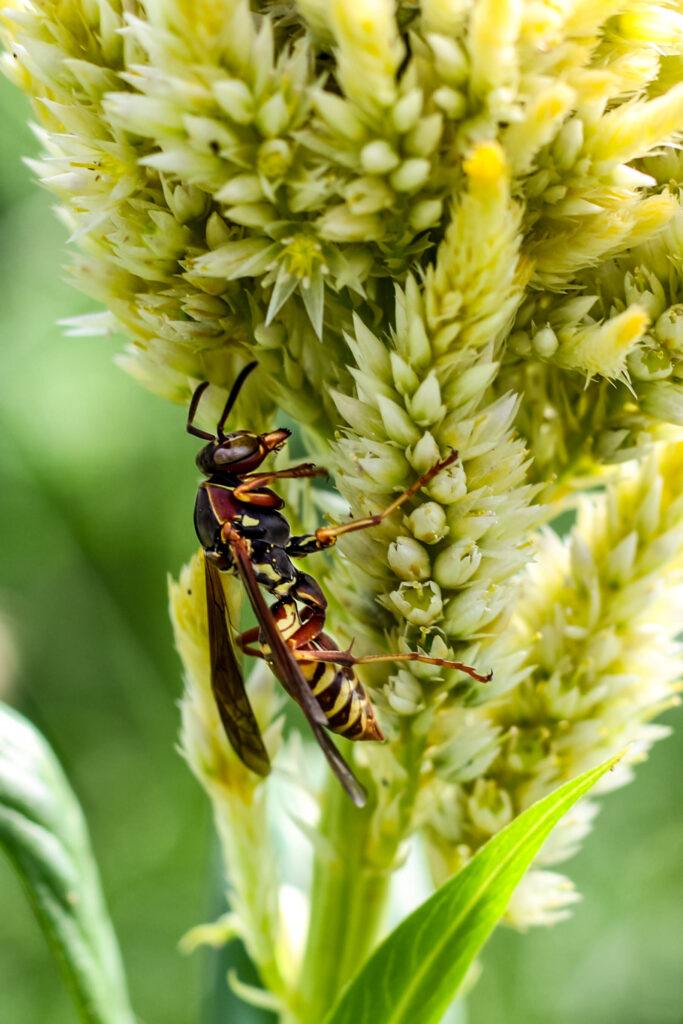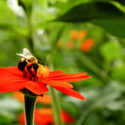Bzzzzzzzt.
There are few sounds as universally recognizable as the buzzing of a bee.
But it’s a noise you may hear a little less often now, as bee colonies have been declining for years. Bees are a vital part of ecosystems and provide much-needed pollination, especially in areas that rely heavily on agricultural output. In Iowa, where most land is private, conservationists are fighting to bridge the gap between agriculture and protecting pollinators.
Meet the Pollinators
Pollinators are keystone species, so if they survive and thrive, the rest of the ecosystem can do the same, but without them, the whole system collapses.
Iowa’s pollinator populations are vast. The state has roughly 400 native bee species, 110 reproducing butterflies and over 2,000 species of moths. Flies, wasps and beetles are also classified as pollinators.
Despite the wide variety of species, bees are the only direct pollinators. They intentionally search for pollen, collect it and transport it back to their hive to feed themselves and their offspring. Additionally, bees consume pollen throughout their entire lifecycle, unlike other insects.
Wasps, flies, butterflies and moths, on the other hand, all pollinate by accident. “They’re just fumbling around just living their best lives and accidentally moving pollen while they’re doing it,” said Sarah Nizzi, pollinator conservation planner and national resources conservation service partner biologist for the Xerces Society.
Iowa isn’t exempt from the problems facing pollinators around the world. The state has two endangered butterfly species, five threatened butterfly species and 25 butterfly species that are of special concern. In short, nearly a quarter of Iowa’s butterfly species are considered at risk to some degree. Of the 14 known species of bees found in Iowa, five of them are at risk.
Pollinators and Agriculture
Pollinators play a necessary part in the production of agriculture.
“Over a third of the world’s crops either are dependent or reliant on pollinators for their production, which oftentimes are the most nutritious and healthiest foods that we consume,” Nizzi said. While Iowa is known for soybeans and corn – both of which are wind-pollinated – a variety of crops grown in the Midwest, as well as the native prairie landscapes, still require the hard work of pollinators.
Additionally, pollinators also play a key role in maintaining genetic diversity in plants.
“A plant wants its pollen to be spread because that’s how it spreads its genetics and reproduces,” said Cassie Cook, a conservation ecologist with Polk County, Iowa.
Pollen contains the genetic material needed for a plant to create a new seed. When a pollinator visits a variety of plants, it intermixes the genetic material, which leads to more robust populations.
“The chance that a species will persist throughout a disaster is higher if you have greater genetic diversity,” Cook said. “It ensures their longevity on landscape and ecosystem.”
Because pollinators and agriculture are so tightly intertwined, finding solutions to protect pollinator populations requires mutual benefits.
“In order to really make headway in conservation in Iowa – if that’s for pollinators or for anything else, water quality, soil health, anything – we need to bridge the gap between conservation and agriculture and find a balance between the two,” Nizzi said.

Finding Middle Ground
For Nizzi, the first step in balancing the needs of Iowa’s agricultural and pollinators is having a conversation with farmers, landowners or whoever she’s working with.
“Something to think about is how can we create better connectivity and corridors just to provide pollinators with areas to go where there’s not one patch of prairie and then a mile all around it is neighborhoods or farm fields where there’s nothing else for them,” Cook said.
Nizzi tries to target marginal land that isn’t producing well or making money for the landowner. Not farming those pieces of land may even save them money in the long run. Cultivating those areas with native plants helps pollinators by giving them access to much-needed pollen sources.
That process can be even more beneficial to landowners who farm diversified crops.
“Oftentimes the crops they are growing are reliant to some degree on pollinators,” Nizzi said. “To have that mutual benefit where habitat on the farm is going to be even easier to get a direct benefit.”

Iowa’s Efforts
When it comes to protecting pollinators in Iowa, it’s all about education. Because so much of the state’s land is privately owned, changes must come from individual landowners. Nizzi gives at least a dozen talks every year on pollinators to the public.
“The public perception and the awareness and the eagerness to learn about it has certainly increased,” Nizzi said. “So, that’s good for conservation. That means people are thinking, they’re caring.”
Iowa is also launching a bumblebee atlas this spring. Essentially a hunt for bumblebees, the atlas will inspire community members to become momentary scientists. Participants will be assigned a grid in which they will conduct two surveys throughout the summer. This three-year project will provide a baseline for bumblebee populations throughout the state.
“It’s important to know what species we have and where they are and what habitats they’re occupying at certain times so that we can better manage for them,” Nizzi said.
Luckily for these pollinators, Iowa community members are passionate about conserving them.
“A lot of groups are really starting to take charge and put more effort into this because the decline has been noticed,” Cook said. “The sooner we can start remediating that the better because we don’t want to get to a place where you know too many species are lost because we may not be able to rebound.”
Join the Fight
Ecologists and apiarists aren’t the only people who can make a concerted effort to protect bees. There’s an abundance of little changes homeowners (or even apartment-dwellers) can make to lend their backyard pollinator population a hand.
Provide a water source
While bees collect pollen, they are also in search of water to bring back to their hive. At beekeeper Grace Long’s house, her family puts out a plastic kiddie pool, especially during the hot summer months, to give bees a place to find water. “Bees are typically attracted to really bright colors because flowers are typically bright,” Long said. “So, even a brightly colored bowl could be something that if you have bees nearby, they would be attracted to and would help them to thrive.”
Habitat Help
Pollinator conservation can even be an excuse to skimp out on some yard work. Leave your leaves and don’t cut back vegetation in the fall. This provides food, nesting and overwintering shelter for invertebrates and pollinators alike.
Flowering Plants
If you’ve got a green thumb, tending to a garden of native plants (or even a potted flower or two) can help pollinators find a food source, especially in heavily developed areas. “You can have flowering plants that span all seasons – so some that flower in early spring, some that flower in the summer and some that flower in the fall – you’re providing a really valuable resource for pollinators year-round,” Cook said.

